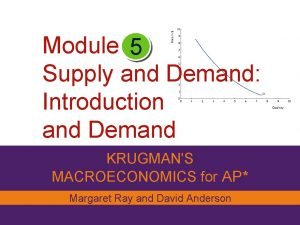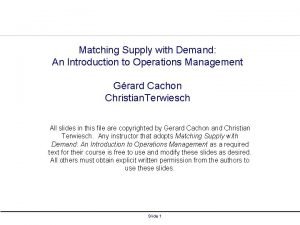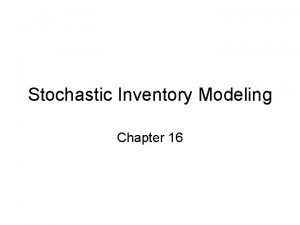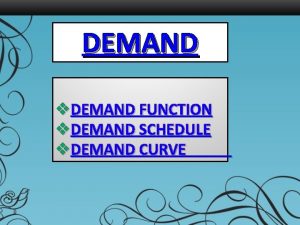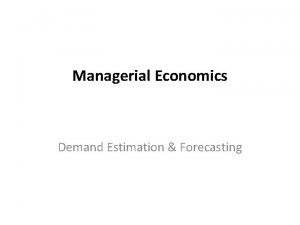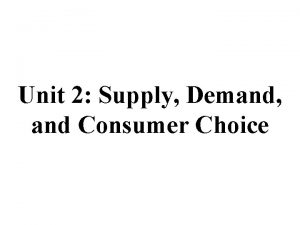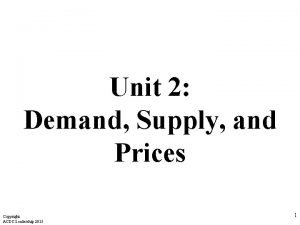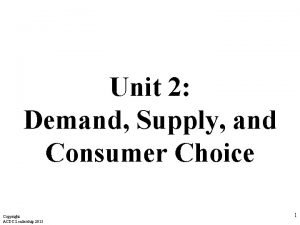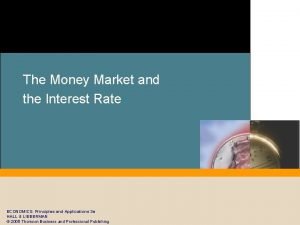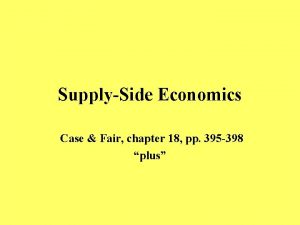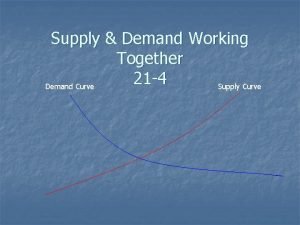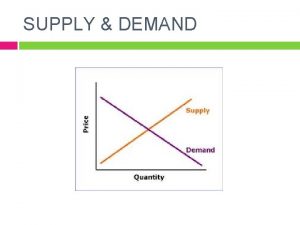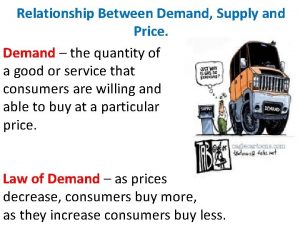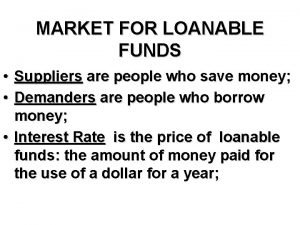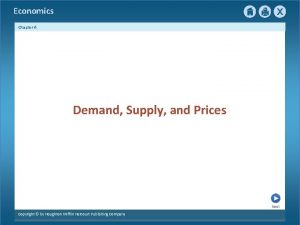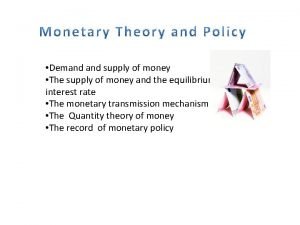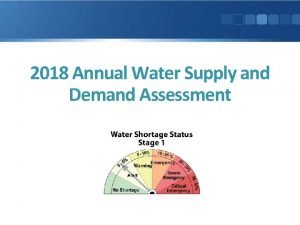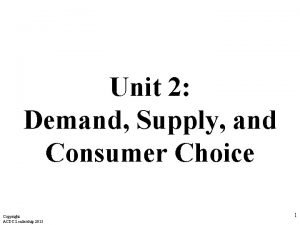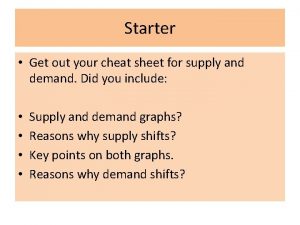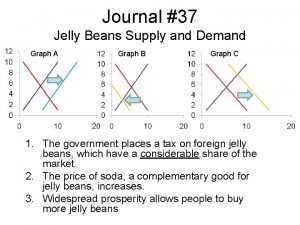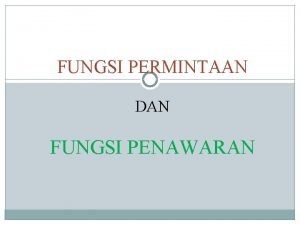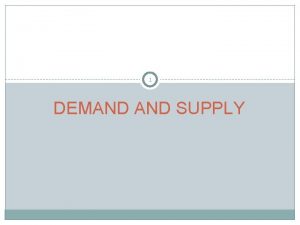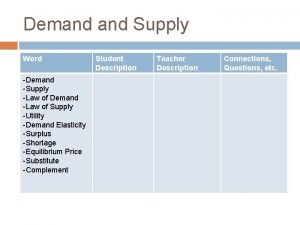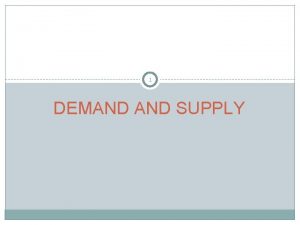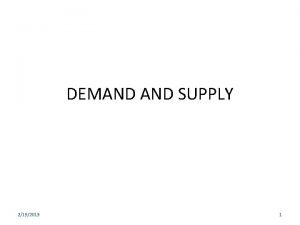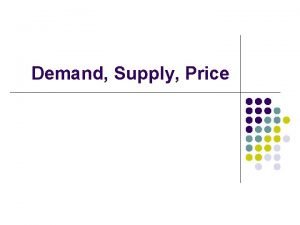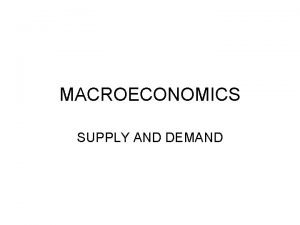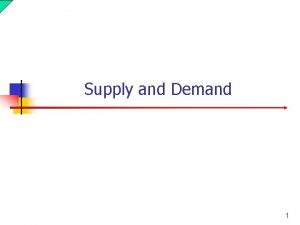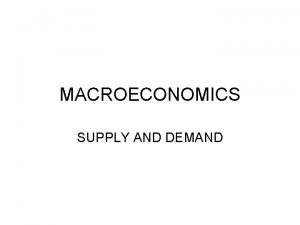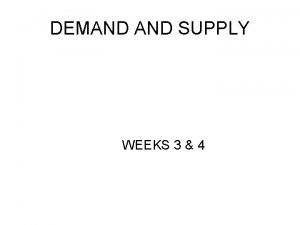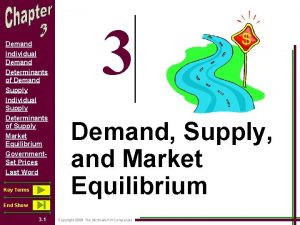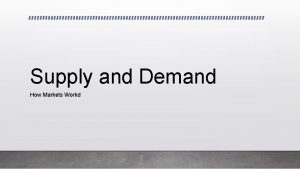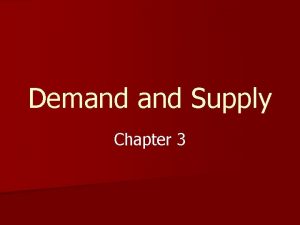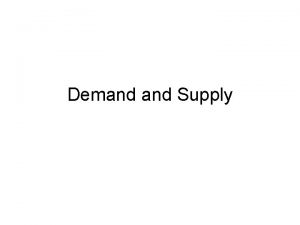Supply Demand Test on Tuesday 1208 Setting an






































- Slides: 38

Supply & Demand Test on Tuesday 12/08




Setting an Economy’s Price System n The forces that determine price are called the forces of supply and demand n The place where these two forces meet is called the marketplace

Demand n Demand is a schedule which shows the various amounts of a product that consumers are willing and able to buy at each price during a specified time periodn e. g. Swimming suits have a different price and quantity demanded in summer vs. winter

Law of Demand n Law of Demand says that as the price of an item decreases, the quantity demanded will increase; and, as the price of an item increases, the quantity demanded will decrease

Demand Curve n Demand Curve is a line graph that shows the amount of a product that will be purchased at each price; it shows an inverse relationship and is always downsloping D Qd

Remember: n. A change along the curve indicates a change in price and a change in quantity demanded n. A change of the curve (right or left) indicates an across the board change in demand

Supply n Supply is a schedule which shows the amounts of a good or service a producer is willing and able to make available at each price during a specified time period n Law of Supply states that the quantity of a commodity supplied varies directly with its price: the number of goods and services offered for sale increases as the price increases.

Supply Curve n Supply Curve will always be upsloping. S

Equilibrium Price n Equilibrium Price (also called the Market price) is the price at which goods and services may actually be bought and sold. n Equilibrium Price is where quantity demanded is equal to the quantity supplied n Market in Wheat Game

Equilibrium Price S EP D

Remember………. . A change along the curve indicates a change in price and a change in quantity supplied A change of the curve (right or left) indicates an across the board change in supply

The Factors that AFFECT DEMANS

1. Seasonality/ changes in # of consumers § More lemonade will be demanded § More bathing suits will be demanded § More sun tan lotion will be demanded

2. Trends/changes in consumer taste n Advertising creates trends n Gap Everybody in vests! n Everybody in leather n Everybody in stripes n n Some advertising can decrease demand n SUV = Terrorism

3. Change in Income n A raise in income will increase demand for superior goods ( Rolex) and decrease demand for inferior goods ( Timex watch) n Conversely, a decrease in income will increase demand for inferior goods ( Timex) and decrease demand for superior goods ( Rolex)

4. Expectations n If the Farmer’s Almanac forecasts a cold winter people may demand more snow tires and rock salt

5. Price of Related Goods n Substitute Goods n Complementary Goods n A rise in the price of one n An increase in the price (e. g. butter) may increase the demand for the substitute ( margarine) n This is a direct relationship of one good ( e. g cameras) will decrease the demand for the complementary good (film/memory cards). n This is an inverse relationship

6. Demographics n Number and Kinds of Buyers in the Market can change demand n Baby Boomers are getting ready to retires n Increased Demand for: More housing in Florida and Arizona n Assisted Living Complexes n Walkers n Wheelchairs n


Factors of Supply What could cause a huge increase or decrease in supply across the board ( and a change in price is not a factor !) n Resource prices ( raw materials) n Technology (produce more products faster & more efficiently n Taxes n Subsidies ( Gov’t grants) n Related Goods ( e. g corn, wheat) n Expectations n Number of Sellers in the Market

How much coffee can you drink ? n. One cup, two, three, four ? n. How does Dunkin Donuts get you to buy more coffee after lunch ?

They offer you a deal…buy a large coffee, get a free muffin or donut Dunkin Donuts knows ALL about the Principle of Diminishing Marginal Utility !!!

Elasticity of Demand n. Elasticity of Demand describes the percentage change in quantity demanded that follows a price change

Elasticity of Demand is elastic if a rise in price results in a large drop in demand is inelastic if a rise in price results in a relatively small or no drop in demand

Steak: Elastic or Inelastic ? n Elastic n Why? People as a whole can do without steak and will substitute chicken or other protein for expensive steak

Milk: Elastic or Inelastic ? n Inelastic n Why? n The population as a whole can do without steak…. but can not do as easily without milk…especially families with children

Gasoline: Elastic or Inelastic ?

What Products are Subject to Elastic Demand ? n Luxury Items – Most customers want luxuries and will consider buying them if price drops n If Price Represents a Large Portion of Family Income n e. g. Mortgage Rates drop from 6. 5 to 5. 5% people will “refinance” n Availability of Substitute Items n e. g. Steak /chicken n Durable Goods n Computers, cars, washers, dryers will be in greater demand if the price drops

Perfectly Elastic Demand Curve n Refers to a situation Price where a small or very $20 small price reduction causes buyers to increase purchases from $15 0 to all they can get n E. g. Foreign currency $10 ( FX Market) $5 n Miniscule changes in currency exchange rate would prompt FX brokers $0 to buy (or sell !) large amounts of money Qd 0 2 4 6 8 10 Quantity Demanded

Perfectly Inelastic Demand Curve Price n Refers to a situation where no change takes place in Quantity demanded as a result of a change in price Examples: n Diabetic – insulin n Addict - heroin $20 $15 $10 n $5 0 0 2 4 6 8 10 Quantity Demanded of Insulin Qd

Market Disequilibrium n Price Ceilings and Price Floors cause market disequilibrium because they disrupt the natural dynamics of the marketplace (supply and demand)

Price Floors: n Price floor are prices below which it is illegal to buy or sell. n n Federal Min Wage = $7. 25/hr RI State Min Wage= $7. 40/hr n Dilemma: Some argue that Mc. Donald’s Worker and other fast food workers generally earn minimum wage laws disrupt the equilibrium in the market and actually increase unemployment n Why? left to the forces of supply and demand more workers would be hired at LOWER wages, decreasing unemployment.

Ohio Kansas States with minimum wage rates higher than the Federal States with no minimum wage law States with minimum wage rates the same as the Federal States with minimum wage rates lower than the Federal American Samoa has special minimum wage rates

Price Ceilings: n Prices above which it is illegal to buy or sell n Examples: n n Rent controlled apartment buildings in cities Certain goods and services during emergencies. n Dilemma: Since rents are frozen, many landlords cannot keep up with the rising costs of maintenance – which have not been frozen ! n They stand in the way of market forces of supply and demand

 Module 5 supply and demand introduction and demand
Module 5 supply and demand introduction and demand Matching supply and demand in supply chain
Matching supply and demand in supply chain Supply and demand unit test
Supply and demand unit test Inventory modeling
Inventory modeling Measures to correct deficient demand
Measures to correct deficient demand Market demand curve
Market demand curve Dependent demand operations management
Dependent demand operations management Grapikong paglalarawan halimbawa
Grapikong paglalarawan halimbawa Independent demand examples
Independent demand examples Demand estimation in managerial economics
Demand estimation in managerial economics Distinguish between individual demand and market demand
Distinguish between individual demand and market demand Inventory models for independent demand
Inventory models for independent demand Unit 2 demand supply and consumer choice
Unit 2 demand supply and consumer choice Shifters of supply
Shifters of supply Unit 2 demand supply and consumer choice
Unit 2 demand supply and consumer choice Money market equilibrium
Money market equilibrium Supply side economics vs keynesian
Supply side economics vs keynesian Combining supply and demand worksheet
Combining supply and demand worksheet Interaction of demand and supply
Interaction of demand and supply Combining supply and demand worksheet
Combining supply and demand worksheet Supply and demand of loanable funds
Supply and demand of loanable funds Shifters of loanable funds demand curve
Shifters of loanable funds demand curve Supply and demand economics project
Supply and demand economics project Chapter 6 section 1 price supply and demand together
Chapter 6 section 1 price supply and demand together Money supply curve
Money supply curve Rule of supply and demand
Rule of supply and demand Long run aggregate supply curve
Long run aggregate supply curve Aggregate of chapter 6
Aggregate of chapter 6 Shift in sras curve
Shift in sras curve Aggregate demand supply graph
Aggregate demand supply graph Annual water supply and demand assessment
Annual water supply and demand assessment Ad curve graph
Ad curve graph Unit 2 demand supply and consumer choice
Unit 2 demand supply and consumer choice Supply and demand together
Supply and demand together Demand n supply
Demand n supply Supply and demand cheat sheet
Supply and demand cheat sheet Conclusion of supply and demand
Conclusion of supply and demand Jelly beans supply and demand
Jelly beans supply and demand Fungsi permintaan rumus
Fungsi permintaan rumus
